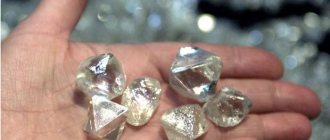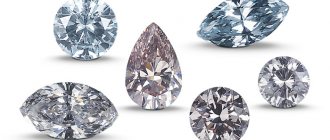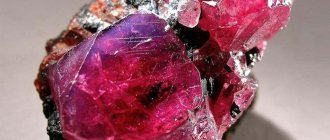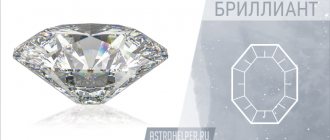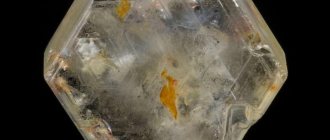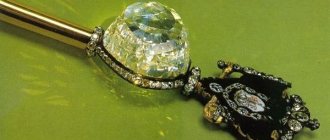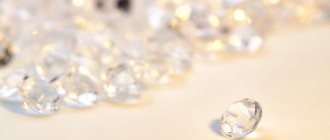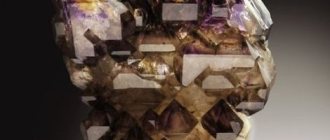Story
Diamond is the true king of precious stones. But it received recognition only after they in the 15th century .
The mineral got its name from the Arabic word “almas,” which translates as “the hardest.” Each nation called this nugget differently, but all the names had similar meanings - “indestructible”, “solid”, “eternal”.
The Greeks called it "adamas", the Romans - "diamond", the British - "diamond". The designation for gem came into Russian from the Turkic “al mass”.
Like many gems, the diamond began its historical journey from the treasuries of Indian rulers. In India they mined this stone, but they did not know how to cut it due to the super-hardness of the nugget. Diamond became among the Hindus a symbol of firmness and inviolability of power.
When Alexander the Great brought a certain amount of these gems from his Indian campaign, Europe and the Middle East became acquainted with diamond nuggets.
A diamond gained its true brilliance and glory after being cut into a diamond. We learned how to cut super-hard stone in Flanders. There, after some time, they developed a cut with 57 facets, and the outfits of gentlemen and ladies of the Rococo era sparkled with diamonds. Since then, the diamond has become the most valuable gemstone available to few.
History of the mineral
Since ancient times, a diamond has been considered a symbol of power, success, luxury, and victory.
The birthplace of this gem is India. Europe became acquainted with the mineral only in the 5-6th century BC.
In those days, diamonds were valued for their healing properties, durability and, of course, aesthetic properties. Only people belonging to the upper classes were allowed to wear jewelry with this stone.
They learned to process stone with the required cut much later. The first diamond was created by Louis de Bernel in the 15th century, and the first owner was the Duke of Burgundy, Charles the Bold.
Origin
Most scientists believe that diamond nuggets form in the mantle that covers the Earth's core. The condition for their formation from carbon is mega-high pressure (over 50,000 atmospheres!) and very high temperature.
This mineral is known to be found in asteroids that fall on our planet. Scientists estimate the age of some diamonds of cosmic origin to be billions of years old , that is, they are older than the Sun.
Types of diamonds found in nature:
- single crystals or their fragments;
- fused crystals;
- polycrystalline formations from the smallest grains of diamond.
Diamond mineral: description, formula and properties
Blue stone diamond
Today there are several theories about how diamonds are formed. For example, according to one of them, diamond appears in nature when the temperature of silicates (silicon compounds with oxygen) located in the mantle of the Earth’s crust decreases.
They appear on the surface after strong deep-seated explosions. In addition, it is believed that these crystals were formed during the fall of meteorites as a result of simultaneous exposure to high pressure and temperature.
Diamond, the formula of which is designated by one letter C, was previously mined by carefully washing sea or river placers of sand. Then there was a small chance of finding such a desired crystal, which could turn out to be an inclusion in other rocks.
But when kimberlite pipes were discovered at the end of the nineteenth century, mining began to be carried out in a different way. This name was given to areas of rock containing valuable minerals and having a vertical conical shape.
It’s interesting what a diamond looks like in its rough form – these are small (up to 5 mm) particles, matte and rough. Small crystals can grow together.
The physical properties of diamond distinguish it from other minerals, but it consists only of carbon atoms.
Its most amazing qualities are the following:
- The density of a diamond on the Mohs scale is 10. This is the maximum value, which confirms the exceptional hardness of a diamond. It is extremely difficult to process, because it damages any material, but it itself remains without any traces.
- The stone’s ability to generate electrical impulses when charged particles interact with it is also amazing.
- The properties of diamond to resist the action of strong acids are also interesting. They cannot have any effect, but when reacting with molten alkali, saltpeter and soda, an oxidation process occurs that can “burn” the sample.
- The melting point of diamond is 3700-4000C°. If you direct a stream of oxygen at the sample, at a temperature of about 800C° it will light up with a blue flame. At 1000C° it will burn, and when heated to 2000C° in a vacuum it will turn into graphite.
The structure of diamond is also interesting, which explains its incredible strength.
The crystal lattice of diamond has the shape of a cube, on the tops of which and inside there are carbon atoms, the strong bond between which gives the mineral its hardness.
Physicochemical characteristics
Scientists began exploring diamond in the 18th century . Its main distinctive features are revealed. Diamond Characteristics:
- It consists of pure carbon, that is, it is a nugget. Chemical formula - C.
- Durable under normal conditions. In a vacuum or in an inert gas at high temperatures it turns into graphite. Interestingly, diamond is the hardest mineral, and graphite is the softest. The reason for this is that the shape of the crystal lattice of diamond is cubic, while that of graphite is layered.
- Increased hardness (10 on the Mohs scale) is combined with fragility.
- Highest modulus of elasticity and compression ratio. It is impossible to compress a diamond, only crush it.
- Color - colorless, brown, yellow, blue, blue, green, pink, red, black.
- Luster - diamond (in black stone - satin or weak diamond).
- Transparency - transparent (black diamond - translucent or opaque).
- The cleavage is perfect.
- The fracture is conchoidal to splinter-like.
- Density (specific gravity of diamond) - 3.47–3.55 g/cm3 .
- Diamond stroke color is missing.
Optical properties of diamond:
- The refractive index of light is 2.417–2.419 (the highest among all gemstones).
- The dispersion of the optical axes is strong.
- Luminescence is an important property of this mineral. Even an uncut stone in the sun and rays close to it in the spectrum plays with different colors (red, yellow, green, blue). This helps to look for nuggets in diamond-bearing veins.
The shapes of diamond crystals are very diverse; they are divided into 2 groups : flat-sided and curved crystals.
Color and shine
The types of diamonds and their color qualities directly depend on what impurities they contain. Despite the small percentage of foreign inclusions, they have a decisive influence on the color and shine of stones.
For example, the influence of nitrogen, iron and boron on the color and beauty of iridescence in stone is known, and its unique property of emitting light under the influence of X-ray irradiation depends on the nitrogen content. It is believed that the more nitrogen inclusions in a mineral, the more beautiful and rich it will look.
Minerals of blue colors arise from boron impurities, and pinkish ones are obtained as a result of deformations that the crystal lattice of the stone underwent during its complex formation.
In order to better distinguish diamonds, there is a generally accepted division of them according to color characteristics:
Place of Birth
Previously, diamonds were found in placers of other rocks, often in river sediments. Therefore, it was believed that the formation of nuggets depended on river flow. But in the mid-19th century, geologists found kimberlite pipes.
These are peculiar “abscesses” on the body of the Earth. They consist of igneous rocks, including 10% of them are diamond-bearing. For the first time, kimberlite pipes were discovered near the village of Kimberley in South Africa.
Subsequently, diamond deposits were discovered on all continents except Antarctica. But there are very few large production zones; they are located:
- in Russia;
- Namibia;
- SOUTH AFRICA;
- Botswana;
- Angola;
- Brazil.
This mineral is also found in the USA, Canada, Australia, Kazakhstan, and India (but in this country the diamond deposits are almost depleted).
3 large companies control 70% of the diamond market (mining, cutting, first sales):
- Alrosa in Russia;
- De Beers in Africa;
- Rio Tinto in Brazil.
98 % mined diamonds are yellow specimens, suitable only for industrial use.
In Russia, the search for diamonds began in the mid-19th century , but only a century later rich deposits of these gems were discovered in Yakutia. There, in October 2019, they found an amazing double stone resembling a Russian nesting doll.
“Diamond-matryoshka” has a unique structure: another crystal moves freely inside the stone.
In the entire history of world diamond mining, such a specimen has never been found. Having examined it, experts hypothesized that this unique crystal was formed in this way: first, an internal crystal was formed, and during subsequent growth, an external crystal was formed.
DIAMOND
DIAMOND (from the French brillant - brilliant), a diamond subjected to art. cutting of a special type, which results in max. shine, which makes B. suitable for making expensive jewelry. B. is also the name of the most famous type of cut. B. are widely used in jewelry and for state decoration. regalia, church supplies, as well as some technical equipment. products.
Rice. 1. Diagram of a round diamond cut.
Rice. 2. Life-size “full” cut diamonds.
Naturally polished diamonds can be considered the first diamonds. Diamond cutting began in the 14th century. in Venice, then in Flanders in the 15th century. The diamond cut was invented, the prototype of which is natural crystals shaped like an octahedron and a dodecahedron. The most common cut is the “rose” shape. In the 18th century A square-shaped B. cut appeared - “peruzzi”, then a “regent” cut with strongly rounded corners. Mechanical roughing introduced into the diamond industry at the end. 19th century, made it possible to give the stone a round cut (“old mine”), which most clearly reveals the play and brilliance of the stone (Fig. 1). In 1919 English Eng. M. Tolkovsky in the book. “Diamond Design” has provided the optimal combination of cut angles at which light penetrates the stone and is reflected in such a way that a maximum diamond is created. light play with minimal loss of gloss. It is this principle that underlies modern cutting technologies. A “full” brilliant cut has 57 facets (Fig. 2). There are upper (crown), middle (girdle) and lower (pavilion) parts B. The edges of the lower part are brought together to a point called a spike. The upper face, perpendicular to the B axis, has the shape of a regular octagon. On the crown, in addition to the platform, there are 32 edges placed in three belts. There is B. with a simplified cut - 17 and 33 sides. The production of diamonds begins with sawing a diamond into two or more parts on a machine with a thin (up to 0.1 mm) copper wheel coated with diamond powder. Sawn diamonds (for round diamonds) are ground to shape using a special machine. machine, where the tool is also a diamond. The ground diamond is faceted on a cast iron disk (faceplate), coated with diamond powder, using a quadrant and numerous. devices that allow you to apply edges at strictly defined angles. The cutting is done in such a way that the working surface of the tool corresponds to the direction of the max. diamond hardness. Computer programs have been developed that can significantly increase the productivity of jewelers. Created by the mathematical The model of light scattering in diamonds makes it possible to develop new options for cutting diamonds. With its help, you can determine how light will be refracted in glass with a non-standard cut, which will help you avoid experimenting by trial and error on too expensive real material.
B. is usually described by four characteristics: color, clarity, type of cut, weight in carats. B. are mostly colorless, some of them have shades of pale yellow, yellow, or brown. intensity. B. “pure water” refers to absolutely transparent stones without flaws, which are most highly valued. For the classification of B. by color, the International was adopted in 1978. color scale, which is based on comparison of the color of B. with a set of standard standards. In Russia, color characteristics are usually denoted by numbers. Depending on the mass of the material, the range of the color characteristic scale is different. Thus, B., having 57 sides and weighing up to 0.29 carats, belong to groups 1–7. B. of the same cut from 0.3 ct and above are divided into 9 groups according to color shades.
Colored diamonds (yellow, pink, cognac, orange, purple, red, green, blue, blue and black) are called fancy diamonds and have a very high price. The famous blue B. "Hope" at 45.5 ct is considered the most expensive small object in the world, it is estimated at 200 million dollars.
Almost all B. contain foreign inclusions. To determine the defect-free quality of materials, they are divided into several according to the degree of purity. groups: B. weighing up to 0.3 ct are included in groups 1–9; B. from 0.3 carats and above are divided into 12 groups. When determining the cost of B. Ch. its mass plays a role. Small ones are considered to be weighing up to 0.29 carats, medium – from 0.3 to 0.99 carats and large (“solitaires”) – from 1 carat. B., having a mass of more than 6 carats, are usually sold at auctions. The characteristics of the diamond are described by the formula: for example, 2 Kr 57–0.10 4/2 A: the number “2” means that there are two diamonds in the product, “Kr” is the round cut shape, “57” is the number of faces, “ 0.10" - the mass of both stones, "4/2" - in the numerator "4" is the color group of the stone, in the denominator "2" is the defect group, the letter "A" is the correctness of the cut geometry. B. with the highest characteristics - 1/1A is extremely rare and has a fairly high price; the lowest characteristic for stones weighing up to 0.3 ct is 7/9, for stones weighing more than 0.3 ct – 9/12. Large varieties are known: colorless “Big Star of Africa” (530.02 ct, London), “Yubileiny” (245.35 ct, Washington), “Black Orlov” (189.62 ct, Moscow), yellow “De Beers” (234.50 ct, South Africa), brown “Star of the Earth” (111.59 ct), “Green Dresden” (41.00 ct, Germany), etc.
On average, 250 tons of ore are processed to extract a diamond per carat. The leading producers of botanicals in the world are Belgium, Israel, India, Russia, the USA, and South Africa.
Diamond colors
Almost every specimen of this mineral has its own color and luminescence (the shade of light radiation passed through it).
The color of diamonds is generally yellowish, but it is partially offset by blue luminescence. As a result, the human eye perceives the mineral as colorless.
Transparent diamonds of “pure water” are found only a few times. Only stones with blue luminescence have jewelry quality. In this case, yellowness should be completely absent, but a slight brownish tint is allowed.
Color is a term used by diamond sorters and cutters. It means a slight shade, which determines whether the stone will become a diamond or will be used in industry.
It is not clear exactly how this mineral acquires its color, because there are no impurities in it (the exception is black diamond interspersed with graphite, hematite, and magnetite). It is assumed that the color depends on the degree of exposure of the nugget to natural radiation.
Diamonds of pink and blue shades are rare, and specimens of rich colors (red, blue, green, black) are very rare.
Diamond colors
Whatever the color of a diamond, it is always magnificent. This gem looks great on any person, regardless of gender and type of appearance.
The most valuable diamond is a stone that has no color. The expression “pure diamond” is a kind of sign of quality. This phrase means that a gem dropped into water will merge with it.
In the classification of diamonds by color, several groups are distinguished: from transparent with a gradual increase in color saturation to stones with a gray, yellow or brown hue.
Black brilliant
There is an unusual type of gem - a black diamond. This precious mineral of natural origin is distinguished by its exclusivity and beauty.
The bulk of colored and white diamonds are quite transparent and have a glossy surface, while the black mineral is matte and completely absorbs light rays. Despite this, black diamonds have a remarkable diamond-like luster.
In addition, the black gem has a number of unique qualities. Naturally, its cost is many times higher than the price of diamonds of ordinary shades. Partially transparent stones or gems with gray inclusions cost less. Back to contents
Application
Diamonds are used in jewelry and industry.
Jewelry
A rough diamond is not very beautiful and is not suitable for setting. What gives it its beauty is its cut, which creates conditions for multiple internal reflections.
Not every cut diamond is called a diamond, but only one cut in a special way. The diamond cut is round, with 57 facets and provides the brightest shine of the gem. Now it is the most common.
In addition to this classic type of cut, there is a fancy cut. Its types:
- "oval";
- "pear";
- "princess";
- "marquise";
- "radiant" and others.
Jewelers select the type and shape of the cut based on the size and shape of the raw crystal.
Main diamond cutting centers:
- India, China, Thailand (small stones are cut in these countries);
- Russia and Belgium (produce medium and large diamonds);
- USA (only large ones are produced).
After appropriate processing, the mineral is used in any jewelry.
Only platinum and white or yellow gold are used to set these precious stones.
Industry
The exceptional hardness of diamond has found application in the manufacture of cutters, drills, knives, and scalpels for surgical operations.
Diamond powder (obtained artificially or as waste from processing natural diamonds) is used as an abrasive for sharpening and cutting discs, grinding and polishing wheels, etc.
Diamonds are also used in the nuclear and watch industries, and in quantum computers.
Microelectronics on diamond substrates is being developed. There are already products that have high thermal and radiation resistance.
The industrial demand for this mineral contributes to the expansion of the production of artificial diamonds.
Diamond making
The diamond manufacturing process consists of the following operations:
1) production research and marking of rough diamonds;
2) splitting;
3) sawing;
4) turning (peeling);
5) cut.
Depending on the quality of the rough diamond, it is not necessary to use all five operations. For example, when making diamonds from fragments, sawing and cleaving are sometimes not required, and when making baguette and emerald shaped diamonds, there is no need for roughing. But when making diamonds of any shape and type of cut, two operations are required: production research and marking of raw materials and cutting!
Let's look at each operation in more detail:
1. The purpose of industrial research of diamond crystals is to study the morphological characteristics of each crystal, compare the cost of raw materials, the yield, the price of diamonds that can be obtained from the crystal, and, based on the analysis, determine the technological direction of its processing.
REFERENCE
Yield is a professional term in diamond processing: the ratio of the mass of the resulting diamond (diamonds) to the mass of the original rough diamonds.
Production examination and marking of diamonds is the first operation in the technological cycle of diamond production. It includes:
— sorting of rough diamonds into diamonds of various shapes;
— determination of the shape of diamonds that can be obtained from diamond crystals (taking into account the maximum yield and the highest cost of the diamond);
— determination of the order of technological processing of raw materials;
— determination and drawing of the plane of sawing or splitting of diamond crystals.
Currently, when performing this operation, computer marking systems are used, such as Sarin, which make it possible to scan the crystal under study with high accuracy, build its three-dimensional model, and make the most optimal calculation of marking options in terms of various shapes of cutting future diamonds and varying degrees of removal of natural defects.
Figure 3. Mechanical sawing. Laser sawing. Sawed diamond crystals: on the right – symmetrical sawing, on the left – asymmetrical
2. Splitting. This is the ability to split crystals into pieces in a certain crystallographic direction. Currently rarely used - it is an alternative operation to sawing.
3. Sawing diamonds is an operation necessary to separate crystals into parts for the purpose of rational use of rough diamonds when processing them into diamonds. Using sawing, various defects located on the cutting path, as well as those located near the cutting plane, are removed. In addition to traditional mechanical sawing sections, laser complexes are currently used to significantly reduce the labor intensity of sawing crystal intergrowths and crystals with ingrowths in the cutting plane.
Figure 4. Manual and automatic turning of diamond blanks. Type of workpieces after processing
Workpieces after sanding
4. Grinding (or roughing) diamonds is one of the most critical operations in the technological cycle of diamond production. The utilization rate of rough diamonds and the quality of finished diamonds largely depend on its implementation. During the honing process, the diamond is given the shape of the future diamond in plan to prepare it for cutting. In addition, during the turning process, the quality of the processed diamond improves due to the complete or partial elimination of defects.
Turning occurs in several stages:
1. Stitching (knocking down) the tops of the workpiece - rough turning. The purpose of the first stage of processing is to prepare the diamond for the main turning process and to pre-shape the workpiece in plan.
2. Finish turning – the second stage of turning, which provides the goal of obtaining a workpiece of the required shape, specified diameter and height of the belt. It is performed in two ways - with a diamond cutter manually or with a diamond wheel (GOST 16167-80).
3. Finishing - the final stage of processing - is carried out with a sharp edge of the cutter at maximum spindle speed, while the sharp edge of the cutter is given a rigid, fixed position so that it eliminates all the irregularities of the workpiece being turned, and does not repeat its outline. The diamond removal during finishing is minimal until the specified parameters are met: the cutter, as it were, only removes burrs from the surface of the workpiece.
PLEASE NOTE: there are operations similar to turning - cutting out a shape with a laser. They are used for such fancy cut shapes as oval, marquise, and pear.
Figure 5. The process of cutting a diamond into a brilliant. A semi-finished diamond blank fixed in a cutting device. Finished Diamonds
IT IS IMPORTANT! Combined processing is carried out to obtain optimal values for the diameter and height of the belt when turning semi-finished products with defects, as well as semi-finished products with a diameter of over 3.0 mm.
Combined processing includes the following operations:
1) preliminary (rough) turning;
2) sanding;
3) finishing (final) turning or again grinding - depending on the degree of removal of defects;
4) turning.
Polishing is a preliminary cutting operation. The purpose of the grinding operation is to give diamonds a shape acceptable for processing in subsequent operations of the technological process, as well as to remove defects from the surface zone of the processed faces.
Figure 6. Diamond washing process
5. Cutting is a technological process of processing natural and synthetic minerals in order to give them a certain aesthetic shape, achieve a high light effect and shine specific to a given mineral, as well as eliminate natural defects - inclusions, cracks, gouges, etc., found in minerals.
The cutting process is carried out in two stages:
1) grinding – removal of the bulk of the mineral by applying edges of a certain shape to the surface of the workpiece;
2) polishing – giving polished surfaces a mirror shine by removing marks left from grinding.
Figure 7. Diamond evaluation area
IT IS IMPORTANT! After cutting, diamonds must be thoroughly washed to remove contaminants in order to correctly assess their value. Diamond washing is a separate operation and is carried out centrally in a specially equipped area. Before washing, diamonds coming from production sites are assembled into small batches by weight. Concentrated sulfuric acid with the addition of potassium nitrate is used as a cleaning solution.
Artificial diamond
Diamond has properties valuable to science and industry. The world demand, primarily for technical specimens, amounts to millions of carats .
At the end of the 30s of the 20th century, Soviet physicist Ovsey Leypunsky calculated the equilibrium curve between diamond and graphite, that is, he determined the conditions for diamond crystallization. It was published in 1939 But O.I. Leypunsky's discovery was registered only in 1971 .
And before that, in the 1950s–1960s , Swedish, American and Soviet scientists independently obtained diamond crystals using different synthesis conditions.
In the 1960s, the technology of diamond synthesis for industrial needs was created and introduced into mass production in the USSR.
Artificially grown stones are similar to natural ones in composition and structure. They do not consist of synthetic materials, so the term “synthetic” in relation to them is not entirely correct.
Artificial diamond
Currently, there is an active development of technologies for the artificial cultivation of precious stones and their likes. Naturally, the bulk of manufacturers, jewelers and buyers are interested in the possibility of creating the king of precious minerals - diamond. This is determined by the price of the gem.
The high cost of diamonds is associated with their unique properties, for example, phenomenal hardness, excellent ability to refract light rays and return them, creating an exceptional play of light and the brilliance of a cut diamond. However, there is an important factor that does not allow the value of the stone to fall according to the laws of competition - the monopolization of the diamond market and the secrecy of jewelry mining.
Synthetic diamonds grown in laboratories have a number of disadvantages:
- Color. It is quite easy to synthesize a stone with a rich color, but reproducing the natural transparency of a diamond is still an unsolved problem.
- Foreign matter such as black carbon filaments.
- The presence of impurities makes it easy to identify artificial stones using a spectrogram.
- Presence of characteristic fluorescence.
Medicinal properties
Diamond and diamond have a general healing effect on the body.
They help with many diseases, but when using them for this purpose, one should not neglect the treatment prescribed by the doctor.
This stone has a positive effect on many diseases, for example:
- for diseases of the stomach and liver;
- heart problems;
- diseases of the lower respiratory organs.
In addition, it produces a sedative effect.
Diamond jewelry promotes mental clarity and good health.
Blue or green diamond is believed to be beneficial for pregnant women.
Magic properties
Diamond is a stone with very strong positive energy. With its help, the owner’s aura is strengthened - this is the main meaning of a diamond for a person.
The diamond nugget is considered a symbol of innocence, courage and toughness.
The character of this stone is capricious. He belongs to the element of Fire and does not like people whose zodiac sign is associated with the element of Water.
His attitude towards others is peculiar: he enhances a person’s positive qualities and punishes negative qualities. If, after you got a diamond, a streak of troubles began, you should think: maybe you are not as good a person as you think.
If the owner of the gem is a kind, generous, self-confident person, the diamond will become his faithful assistant. It is believed that it will help you find true love, good luck in all matters, and ensure prosperity and long life.
Diamond is a powerful amulet that protects against any evil. If a sorcerer wants to harm a person, then the mineral will bring down all these misfortunes on the sorcerer himself.
In ancient times, it was believed that this nugget protected against attacks by wild animals.
Diamond is considered one of the powerful love talismans, so diamond jewelry is very suitable for an engagement or wedding.
Esotericists believe that this stone reveals its magical properties only if it is given as a gift or inherited. A diamond manifests its magical properties in full force only 7 years after a person begins to wear it.
AREAS OF APPLICATION
All diamonds extracted from the quarry are immediately divided into two categories: technical and jewelry. The latter have high transparency and a simple shape: in the future, such samples are exported for insertion into jewelry.
Technical specimens, unlike jewelry ones, have a dark color and defects in the form of chips, cracks, deep scratches or inclusions of rock impurities.
It is impractical to grind a diamond from such samples, therefore they are used for industrial needs (see Table):
We recommend: AMETHRINE - a symbol of peace and love, a miracle from Bolivia
| In the construction and metalworking industry. | Drills are made with diamond tips. They are necessary for milling and boring workpieces made of superhard materials. |
| In instrument making | For the manufacture of lenses into photosensitive photocells. |
| In telecommunications | For transmitting electrical signals using diamonds. Cables containing such mineral chips are wear-resistant to environmental factors. |
| In medicine | Necessary for the manufacture of highly specialized instruments that remain sharp for a long time and are used primarily in surgery. |
Who is suitable according to their zodiac sign?
Diamond is a stone of the Fire element, therefore its energy is ideally compatible with the energy of the signs of the Fire element: Aries, Leo, Sagittarius . For representatives of this trine, the stone improves life “on all fronts,” but only if they are pure in soul.
Some astrologers believe that it is also suitable for Libra and Capricorn .
This mineral has a neutral attitude towards the other signs of the zodiac (except those related to the element of Water). But representatives of the “water” trine, Scorpio, Pisces, Cancer , are not recommended to wear it. This is especially true for Pisces - a nugget can take away their psychic energy. The following can be recommended for this sign as talismans and amulets: opal, blue agate, amethyst, euclase, rose quartz, aragonite, spinel, jasper, orthoclase, anhydrite (angelite), prasiolite, pearls.
In addition, Pisces, Scorpio and Cancer are suitable for:
- Moonstone;
- ammolite;
- ammonite;
- Labrador;
- Belomorite.
Cancer also has individual preferences for the following stones: cat's eye, pearl, alexandrite, aventurine, tektite, chrysoberyl, petersite. And for Scorpio - aquamarine, topaz, opal, alexandrite, rhodochrosite, sarder, carnelian (its variety is cornelian), red garnet, unakite, chrysoberyl, howlite, kunzite.
Zodiac astrology specialist Luis Hamon has a special opinion about black diamond. He believes that such a stone can be a lucky stone for Pisces , but only those born on March 8, 17 and 26 , as well as for Aquarius , whose birthday is February 8, 17 and 26 .
Who can wear diamonds from their zodiac signs?
Diamonds are considered the patrons of Aries, Libra and Leo. The mineral will give strength to hardworking Aries. For brave and majestic lions, a diamond will add generosity and courage. For Libra, a diamond will show you the right path.
Representatives of the Capricorn sign should also pay attention to this gem, because diamonds are also favorable to them. Sagittarius will receive greater communication skills and openness from the mineral.
Representatives of the Pisces sign should be careful with this gem. The stone has great influence, which means it can suppress the character of the soft representatives of this sign.
The rest of the zodiac signs should not be afraid of the diamond; the main thing here is to find a common language with an attractive gem.
Compatibility with other stones
Diamond is not only the most expensive and beautiful noble stone, but also the most freedom-loving and strong.
Finding company is very difficult for him. Only precious stones that are close in price are suitable, and not all of them. For example, among garnets, only pyrope is recognized by this mineral. Ruby and spinel, which belong to the element of Fire, are also suitable for him, as is diamond.
A combination with sapphire will not always be successful, since it is associated not only with the element of Air, but also with the antipode of Fire - Water.
Emerald and pearl are excluded from the list of possible neighbors of a diamond, since they belong to the water element.
Diamonds with earth element stones are not worn - they are too cheap for “royal crystals”, and the energy of Fire will suppress these opaque gems.
All this corresponds to one of the systems that determine the compatibility of stones according to the elements that protect them. “Fire” minerals are friends with each other and with Air stones. On the Internet there are stone compatibility tables compiled in accordance with other systems, and the data in them is different.
How to distinguish from a fake
Diamond is often counterfeited. Instead of a diamond, they can slip in a synthetic cubic zirconia stone or even glass.
A popular imitation of diamonds is Swarovski rhinestones made of acrylic and glass.
Sometimes they try to sell colorless transparent stones (quartz, zircon, topaz) under the guise of a diamond. Some of these colorless minerals can also cut glass. Therefore, it is better to entrust the authenticity of diamonds to professional appraisers: they can determine the thermal conductivity of the stone or draw a line along it with a special felt-tip pen. The trace from it on the surface of the diamond is even, but on another mineral or glass the line will be dotted.
You can take a magnifying glass with 12x magnification to the store and look through it in bright light. Cubic zirconia will exhibit the optical effect of doubling the facets, while diamond does not have this effect.
Best time to buy
The most favorable time to buy a diamond is the 15th lunar day . It is recommended to wear jewelry with it for the first time on 29–30 lunar days .
It’s good if the 15th lunar day falls on Saturday or Sunday and if it is sunny .
If you want to purchase a diamond as a talisman or amulet, it is better to take a loved one with you to the store, who will buy it for you and say the phrase: “I give you this ring” (or another thing). After this, the stone in 2 weeks .
Price
A cut diamond is a very expensive gemstone.
Diamonds are graded using the 4C system:
- cut —cut;
- clarity - purity;
- color — color;
- carat - weight in carats.
This helps determine how close a given specimen is to perfection.
The cost of a carat of a colorless diamond without colors or defects, with a standard cut, is about $1,000 .
Of the colored diamonds, the most expensive are red and black, while green and blue are slightly less expensive.
Examples of prices in Russian online stores:
- necklace with 1 diamond (14k white gold) — RUB 22,300. ;
- diamond pendant (14k white gold, product weight 1.39 g) - RUB 33,660. ;
- ring (14k red gold, ring weight 2.55 g) - RUB 36,950. ;
- diamond (0.41 carat) - RUB 69,990.
WHAT OTHER DIFFERENCES A DIAMOND FROM A DIAMOND
Diamonds and polished diamonds sell for different prices, but the cost of the stones and the shine are not the only differences between them.
Other differences include external data, weight, carat content and scope of application.
The greatest jewelry value is represented by transparent crystals without visible cracks or chips, as well as impurities of another type.
Mass of mineral
Before working with it, a natural diamond weighs many times more than the diamond itself. However, it has an inconspicuous shape and color, which does not allow it to be used in the jewelry industry. The material is quite durable and difficult to process.
Subsequently, the crystal turns into an expensive diamond weighing several carats. Most of the precious material is ground into dust during processing.
Diamond
Carat
Another designation for the mass of precious stones, which are diamond and diamond, is measured in carats. 1 carat corresponds to a weight of 0.2 grams.
In modern times, large stones have given way to smaller specimens. Diamonds weighing up to 0.4 grams are more valuable.
Technical stones, accordingly, are measured not in carats, but in grams.
